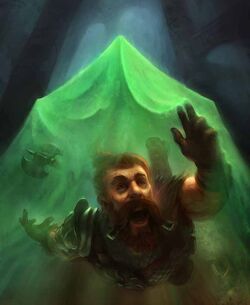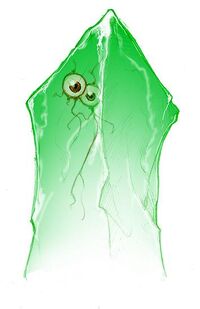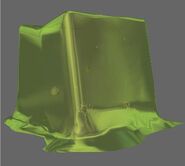A gelatinous cube, also known as an athcoid,[6] was a transparent ooze composed of mindless, gelatinous matter in the shape of a cube or rhombohedron.[1][6] They were especially favored by the drow god Ghaunadaur.[7]
Description
Typically, a gelatinous cube measured between 10 and 15 ft (3‒4.6 m) on a side and weighed as much as 50,000 lb (23,000 kg),[4][3] although legends existed of much larger cubes.[3] The creature was completely transparent, with only a glint of its surface in the light to give away its position.[4] The occasional random object floating in a well fed gelatinous cube's body could also serve as a warning of its presence to dungeon delvers.[1]
Gelatinous cube bodies were remarkably moldable. They could flow around objects and through narrow passages, quickly returning to their shapes once enough space was available.[6]
Behavior
A gelatinous cube was a mindless predator that silently roamed ancient crypts and vaults in regular, predictable patterns.[1] They were more common in heavily frequented dungeons, due to the more readily available food and carrion.[4][3] As they traveled the halls of old ruins, they absorbed any material in their paths from the floors and walls.[2] Although incapable of climbing walls, particularly large gelatinous cubes could also absorb mold and moss from ceilings.[4] Organic material was quickly dissolved in the acidic ooze that made up the cube's body, while bones and inorganic matter spent some time floating within the creature until eventually expelled.[5][1][6] As they slid through the corridors, they left behind a perfectly clean path,[1] except for an occasional slimy trail.[4]
Combat

A gelatinous cube engulfs an adventurer.
Gelatinous cubes could not see or hear, but were capable of sensing vibrations and were attracted to warmth.[6] Despite their slow speed, gelatinous cubes were strong and could easily push back and knock over even large creatures.[3]
When facing an opponent, a gelatinous cube could slam it with an acidic pseudopod or attempt to engulf it.[1] When touching a creature, the cube secreted a gummy paralyzing substance that was immediately absorbed through the skin into the victim's bloodstream. After successfully engulfing a victim, the cube moved pockets of an acidic digestive substance towards the victim's body, quickly digesting it. Despite being extremely effective against flesh and cellulose, the digestive fluid had no effect on inorganic matter or bones.[6][1] Survivors of gelatinous cube attacks displayed scars that resembled partially melted wax.[6]
It was possible, although difficult, for sufficiently strong creatures to escape engulfment by a gelatinous cube.[3] Despite their sizes and homogeneous composition, gelatinous cubes were vulnerable to most usual forms of attack,[1] although reports existed of cubes that were immune to electricity.[4] Mind-altering effects were useless against the mindless creatures.[1][3]
Ecology
Gelatinous cubes reproduced asexually by either dividing themselves into two smaller cubes of equal sizes[6] or via budding. In the second case, a smaller, rubbery cube was excreted into a side corridor or on a pile of refuse, and left to fend for itself until it grew into a full-sized cube. These smaller cubes were not cared for and ran the risk of being absorbed by their own parents on their next trip down the corridor.[4] Surviving young cubes then rapidly grew to adult sizes.[6]
When two gelatinous cubes met, they could temporarily fuse into a larger form that acted like a single creature. They could remain in that fused form for up to a few days before splitting and going their separate ways.[6]
The Imperial Zoo of Amn successfully kept a gelatinous cube in captivity for about 12 years in the mid‒14th century DR.[6]
The adventurer Haptooth claimed to have developed an oral antidote against the gelatinous cube's paralyzing secretion after years exploring Undermountain.[6]
History

Glabbagool, an unusual sentient gelatinous cube.
According to the Demonomicon of Iggwilv, gelatinous cubes and other oozes were either fragments or the spawn of Juiblex. While this claim was not widely believed, the demon lord could exert control over them, imbuing them with a sense of purpose and even intelligence.[8]
The Waterdhavian dungeon complex of Undermountain contained numerous gelatinous cubes.[9] In the late 15th century DR, the wizard Halaster Blackcloak, while experimenting with the duergar ability to enlarge their bodies, created a giant gelatinous cube that measured 30 ft (9.1 m) on a side.[10]
Notable Gelatinous Cubes
- Glabbagool, a sentient gelatinous cube who lived in the Underdark sometime in the late 1480s or 1490s DR.[11]
Appendix
Appearances
- Adventures
- Dungeon #30: "... And a Dozen Eggs"
- Expedition to Undermountain
- Out of the Abyss
- Waterdeep: Dungeon of the Mad Mage
- Video Games
- Eye of the Beholder II: The Legend of Darkmoon
- Baldur's Gate: Dark Alliance
- Neverwinter Nights
- Sword Coast Legends
- Idle Champions of the Forgotten Realms
Gallery
External Links
 Gelatinous cube article at Wikipedia, The Free Encyclopedia.
Gelatinous cube article at Wikipedia, The Free Encyclopedia.
References
- ↑ 1.00 1.01 1.02 1.03 1.04 1.05 1.06 1.07 1.08 1.09 1.10 1.11 Mike Mearls, Jeremy Crawford, Christopher Perkins (2014-09-30). Monster Manual 5th edition. Edited by Scott Fitzgerald Gray. (Wizards of the Coast), pp. 241–242. ISBN 978-0786965614.
- ↑ 2.0 2.1 Mike Mearls, Stephen Schubert, James Wyatt (June 2008). Monster Manual 4th edition. (Wizards of the Coast), p. 202. ISBN 978-0-7869-4852-9.
- ↑ 3.00 3.01 3.02 3.03 3.04 3.05 3.06 3.07 3.08 3.09 3.10 Skip Williams, Jonathan Tweet, Monte Cook (July 2003). Monster Manual v.3.5. (Wizards of the Coast), pp. 201–202. ISBN 0-7869-2893-X.
- ↑ 4.00 4.01 4.02 4.03 4.04 4.05 4.06 4.07 4.08 4.09 4.10 4.11 Doug Stewart (June 1993). Monstrous Manual. (TSR, Inc), pp. 278–279. ISBN 1-5607-6619-0.
- ↑ 5.0 5.1 5.2 5.3 Gary Gygax (December 1977). Monster Manual, 1st edition. (TSR, Inc), p. 43. ISBN 0-935696-00-8.
- ↑ 6.00 6.01 6.02 6.03 6.04 6.05 6.06 6.07 6.08 6.09 6.10 6.11 Ed Greenwood (August 1987). “The Ecology of the Gelatinous Cube”. In Roger E. Moore ed. Dragon #124 (TSR, Inc.), pp. 56–57.
- ↑ Sean K. Reynolds (2002-05-04). Deity Do's and Don'ts (Zipped PDF). Web Enhancement for Faiths and Pantheons. Wizards of the Coast. p. 11. Archived from the original on 2016-11-01. Retrieved on 2018-09-08.
- ↑ Mike Mearls, Jeremy Crawford, Christopher Perkins (2014-09-30). Monster Manual 5th edition. Edited by Scott Fitzgerald Gray. (Wizards of the Coast), p. 240. ISBN 978-0786965614.
- ↑ Eric L. Boyd, Ed Greenwood, Christopher Lindsay, Sean K. Reynolds (June 2007). Expedition to Undermountain. Edited by Bill Slavicsek. (Wizards of the Coast), pp. 143, 148. ISBN 978-0-7869-4157-5.
- ↑ Christopher Perkins (November 2018). Waterdeep: Dungeon of the Mad Mage. Edited by Jeremy Crawford. (Wizards of the Coast), p. 34. ISBN 978-0-7869-6626-4.
- ↑ Christopher Perkins, Adam Lee, Richard Whitters (September 1, 2015). Out of the Abyss. Edited by Jeremy Crawford. (Wizards of the Coast), p. 35. ISBN 978-0-7869-6581-6.

